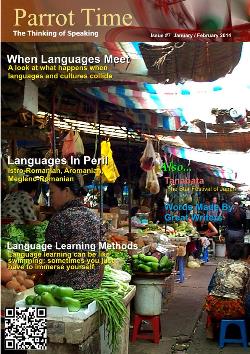
|
Merger Perhaps the most unique result of a clash between languages is the birth of a new one. When two cultures become intertwined, like one group moving into another's region and neither attempts to dominate, the people will mix, as will the languages. Sometimes, one language will become dominant. Other times, the people from both languages will start trying to learn the other one, which results in a linguistic adaptation. This is called a pidgin language. The most basic definition of a pidgin is "a simplified form of speech formed from one or more existing languages, used by people who have no other language in common". This is mostly a result when both sides need to communicate for something like commercial purposes. A pidgin can come to develop its own basic grammar and vocabulary, but those are very simplified compared to the "parent" languages. Most remain small and specialized and are called "trade languages", since the main reason they were created was to make trading between two groups easier. An example of this is what is called "West African Pidgin English". It developed during the a time when the British were running a slave trade in the Atlantic during the late 17th and 18th centuries. The sailors and slave traders spoke English and were in constant contact with African villagers. Both sides had a need to communicate, for business purposes, trading in slaves and goods. The further the British traveled inland, the more the pidgin spread and expanded. The majority of the vocabulary was English based, but much of the grammar, syntax and basic sounds of it came from the local languages, the West African Niger-Congo languages. This pidgin also became specialized, depending on which languages were mixing with the English. Some of the major varieties, with their local names, are Gambian Pidgin English (Aku), Sierra Leone Pidgin English (Krio), Liberian Pidgin English, Ghanaian Pidgin English, Nigerian Pidgin English, and Cameroon Pidgin English (or Kamtok). When dealing with a pidgin, it is often rather easy to understand what is being said if you know the stronger language in the mix. You just have to blur your hearing, in a way. For example, in Nigerian Pidgin English, you might hear "How you dey?", which can easily be understood to mean "How are you doing today?". The words are the same or truncated, with a few extraneous ones being removed. Spelling can also be simplified, such as with "I no no" for "I don't no". The first "no" is used to imply the negative, while the second one is a phonetic spelling of "know". A few more examples are: "Gi mi." = "Give it to me." "I dey fine" = "I’m fine. I’m doing well." "Wetin dey happen?" = "What’s going on? What’s happening?" Sometimes, the meaning might be a little more hidden, coming about because of an idea rather than literal meaning. "Comot!" means "Get out of here!", which might be a corruption of "come out" or "go out", depending on the pronunciation. It might also come from "come on". "Abeg" means "please", coming from "I beg you". Another common aspect of a pidgin is repeating words to emphasize a meaning. "Listen well well" means "Listen very well" or "Pay attention". Note that this is different than "I no no", which is using a different spelling, not repetition. Most pidgins are short term languages, existing only for a few years during the time they are needed. If a pidgin does manage to survive for much longer, it may develop into a creole. When the children of the adults speaking the pidgin start learning it as their native and primary language, it has established itself as a stable language. This process is called nativization. A strange phenomenon which has been noticed among linguistic scholars is that creoles tend to share more grammatical similarities with other creoles than they do with the parent languages. No one has a truly accepted theory on how or why this happens. Perhaps the formation of creoles reflects the most basic grammatical structure the human mind can invent, and that more elaborate grammars develop over a much longer time period, being influenced by the situation of the speakers and the influence of older languages around them. A great many creoles are based upon the French language, because of the great number of colonies France had. For this reason, many people automatically think the term "creole" is related to French things. However, pidgins and creoles can arise out of any mix of languages. The most common basis for creoles are French, Spanish, English, Portuguese, and Dutch. One of the most spoken pidgins is Tok Pisin, spoken by over five million people, mainly in Papua New Guinea, where it is actually the official language. Over one million people are taught it as a first language. Most there speak it to a certain degree, but not always fluently. It is particularly popular among the police and urban families. The name comes from the English words "talk" and "pidgin", although they obviously became simplified into Tok Pisin. The vocabulary is mostly Indo-European, coming mainly from English, German, Portuguese, and Latin, while the rest comes from Malayo-Polynesian and Trans-New-Guinea languages. The grammar structure is much more Austronesian based.  People of Papua New Guinea, speakers of Tok Pisin One interesting aspect of Tok Pisin is its addition of inclusive and exclusive forms of pronouns. While western languages normally just have a singular and plural forms (I, we), Tok Pisin also has a dual and triple form. These are used to define exactly who is involved, and are created by adding the words "tu" and "tri" into the pronoun forms. Tok Pisin also utilizes reduplication, mainly to distinguish between words. The word for "ship" is "sip", but since that might also sound like a corruption of "sheep", it is doubled, so "sheep" is "sipsip". In the Caribbean ABC islands (Aruba, Bonaire and Curaçao), the creole Papiamento is spoken. This one developed from mixing English, Spanish, Portuguese, some indigenous languages, and some Dutch, which is used mainly for the names of the months. Among the islands, it has two dialects, which is an effect of developing on three separated pieces of land. The dialects also have differences in spelling, so even the name of the language is spelled differently, either as Papiamentu or Papiamento. Not all creoles develop from pidgins, and they are not always easily recognized. The language of Afrikaans, spoken in parts of Africa, mainly in South Africa, developed when the Dutch settlers arrived there in the 17th century. It is sometimes referred to as a dialect of Dutch, although it adopted words from other languages, like Malay, Portuguese and Bantu. There are still heated arguments that go on as to whether Afrikaans is an independent language, a dialect of Dutch, or a Dutch creole. There are also a few rare times when a merger, resulting in a creole, may actually become a more dominant form that replaces a parent language, helping to drive it to extinction. On the island of Rama Cay, off the coast of Nicaragua, the indigenous language of the Rama people blended with English to create what is called Rama Cay Creole. As the natives switched to this, the parent language of Rama became abandoned and is now on the verge of extinction. Even stranger, Rama Cay Creole is also struggling to survive, and may also vanish. |
| Special Feature - When Languages Meet | ||||||||||
| Writer: | Erik Zidowecki | |||||||||
| Images: | ||||||||||
| ||||||||||
All images are Copyright - CC BY-SA (Creative Commons Share Alike) by their respective owners, except for Petey, which is Public Domain (PD) or unless otherwise noted.
comments powered by Disqus
















